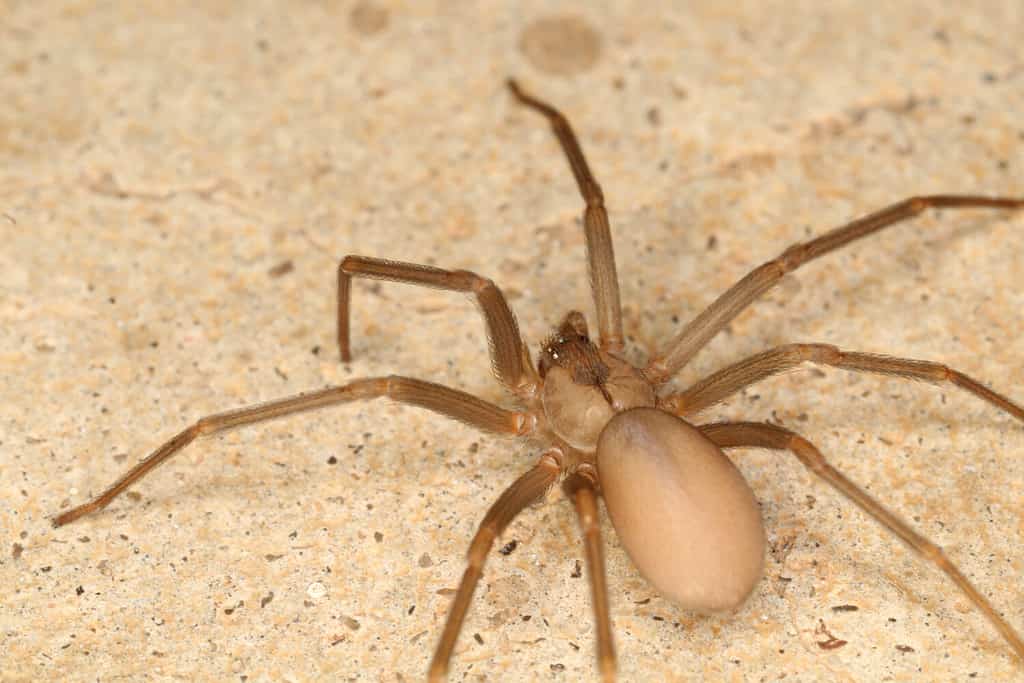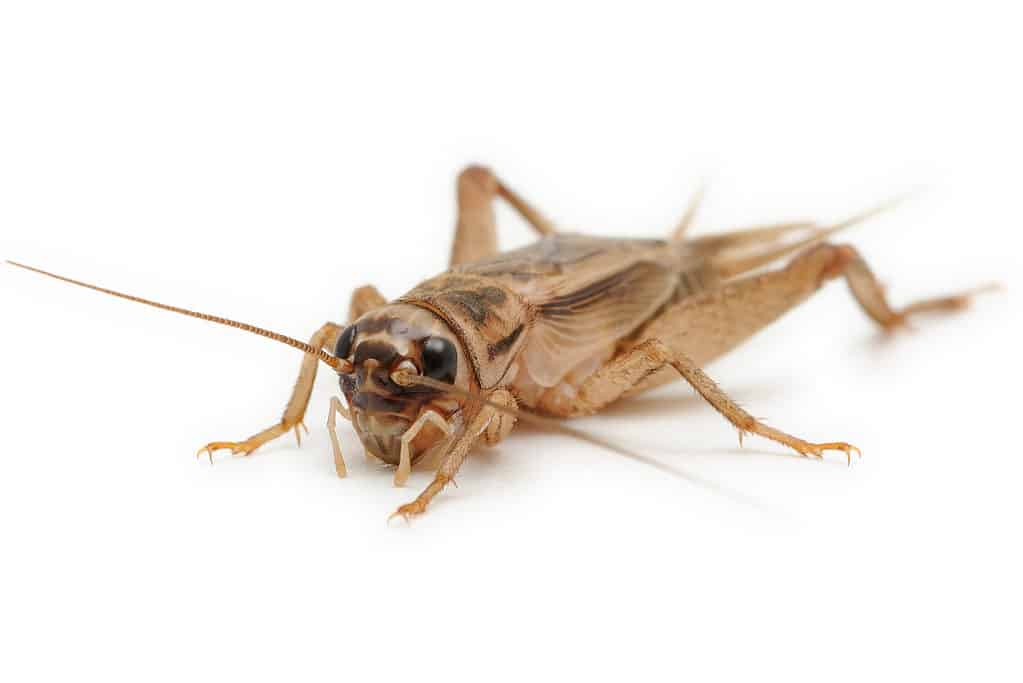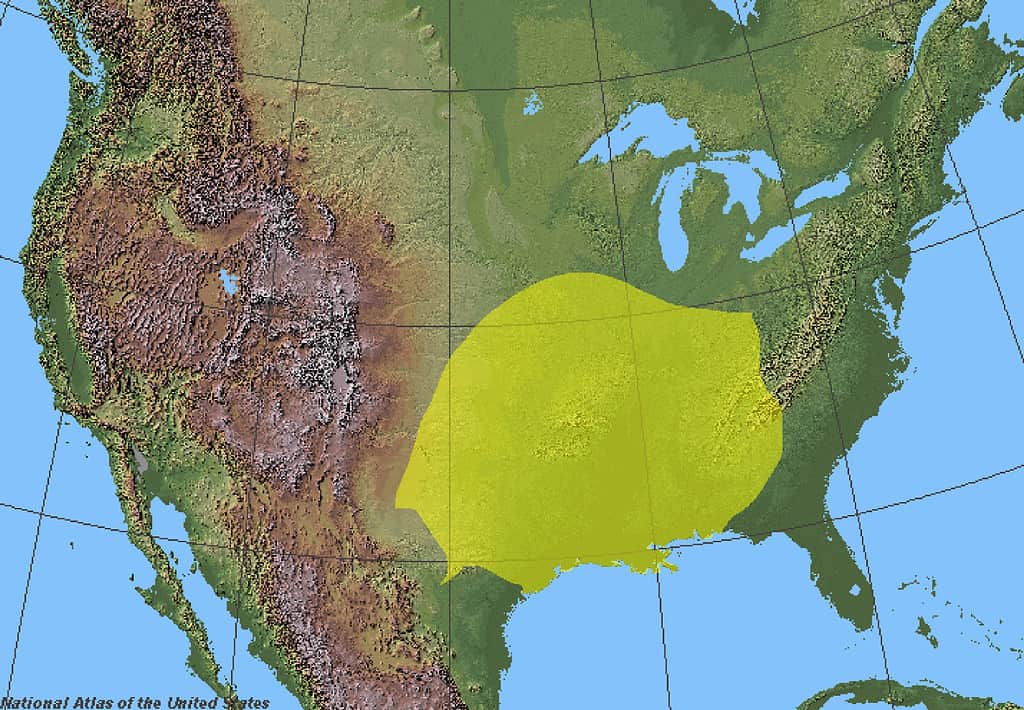The brown recluse spider is one of only three types of spiders in North America with venom strong enough to be dangerous to humans. For many, this tiny arachnid is a dreaded pest, but it’s also an incredibly misunderstood species. If you live in Tennessee, you might just encounter a brown recluse at some point, so it’s worth educating yourself about how these spiders live, what they eat, how to repel and get rid of them, and what to do if you find yourself face-to-face with one. Keep reading to learn more!
What Is a Brown Recluse Spider? Overview and Fun Facts

The traditionally violin-shaped marking on a brown recluse’s back can vary in shape and size, though it is always located on the cephalothorax just behind the eyes.
©Keith Davis/Shutterstock.com
Taxonomically, the brown recluse spider falls under the Loxosceles genus, also collectively known as the recluse spider. Another common name for this group of around 140 total species is the fiddle-back or violin-back spider due to the distinctive dark violin-shaped markings on their backs. These spiders are quite long-lived at around one to two years on average thanks to their hardy nature and ability to go long periods without food or water.
Along with the Chilean recluse spider, the brown recluse is among the most dangerous of the bunch, thanks to its particularly potent necrotic venom that can rapidly destroy the tissues and blood vessels of its bite victims. Despite the spider’s small size at just around half an inch long, its venom can cause a condition called loxoscelism, in which much of the victim’s skin surrounding the site of the bite dies. In severe cases, loxoscelism can also produce symptoms like nausea, vomiting, and even kidney damage.
Fortunately, brown recluse spiders are as, well, reclusive as they are venomous. Bites are very rare, as the spider is non-aggressive and prefers to flee from rather than bite humans. Most commonly, bites occur when the spiders become trapped in a person’s clothing, such as socks or shoes. Deaths from brown recluse bites are even rarer, as the majority of bites cause minor side effects with no tissue death.
Recluse spiders can be found throughout the world on nearly every continent. The brown recluse in particular, however, is primarily native to the southern and southeastern United States. They generally inhabit cluttered yet secluded areas like wood piles, basements, garages, sheds, and closets.
What Do Brown Recluse Spiders Look Like? Identification Tips

The brown recluse can be difficult to identify due to its similar appearance and size to many other spider species.
©Nick626/Shutterstock.com
As we touched on above, the brown recluse’s most distinctive trait is the small, dark brown fiddle-shaped marking on its back, or more accurately, its cephalothorax. This marking tends to darken with age. While insects’ bodies are divided into three sections (a head, thorax, and abdomen), the bodies of arachnids like spiders are divided into two: a fused head and thorax called a cephalothorax, and an abdomen.
It’s worth noting, however, that this violin-shaped marking is not a definitive identifier, as it is also present on many other types of spiders. This can make correctly identifying a brown recluse tricky, especially from a safe distance. Still, there are a few other traits that set it apart from other spiders, most notably the positioning of its eyes.
For a bit more clarification, most spiders have eight eyes that can be arranged in a variety of ways. Brown recluses instead have three pairs of eyes or a total of six. One pair, the median pair, rests in the center and is flanked by a lateral pair on either side. This eye positioning gives the brown recluse’s head a distinctive appearance from those of other spiders.
Like most recluse spiders, brown recluses are also quite small at roughly a half-inch long. Aside from their dark brown fiddle-shaped marking, their bodies are a uniform light to dark brown color. No other markings are present on the body or their long, thin legs.
In general, if you think you’ve spotted a brown recluse, it’s best to exercise extreme caution and not touch or engage the spider directly. We’ll cover some tips and tricks for how to eliminate and repel them below.
What Do Brown Recluses Eat?

Small bugs with soft bodies like crickets are the brown recluse’s ideal prey.
©iStock.com/Florian DENIS
Brown recluses are insectivores that mainly feed on insects with soft bodies like flies, moths, and crickets. Instead of waiting and ensnaring their prey in carefully constructed webs, brown recluses leave their webs at night to actively hunt. Though they are occasionally active during the day, they are mostly nocturnal.
In addition to feeding on live insects, brown recluses will sometimes scavenge their meals, meaning dead insects are fair game, too. Furthermore, the species can have cannibalistic tendencies, particularly in large infestations where many recluses are living in close quarters with one another. They are quite agile and speedy hunters capable of deftly taking down a wide range of insect prey.
Where Do Brown Recluse Spiders Live in Tennessee?

The brown recluse spider’s full geographic range is present here in yellow.
©ReliefUSA_map.gif: Public domain, U.S. government. Derivative work: Bob the Wikipedian, CC BY-SA 3.0, via Wikimedia Commons – Original / License
Brown recluse spiders live in every one of Tennessee’s counties. In its totality, the species’ geographic range covers much of the southern Midwest and part of the southeastern United States. Including Tennessee, the brown recluse spider has established itself in 16 US states.
As we briefly mentioned earlier, brown recluses are very reclusive and primarily inhabit secluded areas. In the wild, they naturally make their webs in dead or rotting wood, such as in wood piles or tree bark. Structures they often live in include sheds, garages, attics, closets, and other mostly wooden buildings.
The web of a brown recluse is irregular and lacks any particular structure or patterning. It has a very loose construction, with lots of thin, white strands overlapping one another. Notably, brown recluses do not build webs to trap their prey–they instead leave their webs at night to hunt. Though they are generally reclusive and avoid one another, they can live in large groups in severe infestations.
Because they hibernate and become dormant in the winter, sightings of these spiders are far more common in the spring and summer months. March through October is when brown recluse spiders are most active in Tennessee.
What to Do if You Find a Brown Recluse Spider

The brown recluse’s distinctive eye arrangement is visible here, with one median pair and a lateral pair on either side.
©Nick626/Shutterstock.com
If you think you’ve encountered a brown recluse spider in your home, it’s important to first and foremost keep a safe distance. Do not get too close, touch it, or engage with it directly until you have a safe and effective plan of action. Although brown recluse bites are rarely deadly, they can be incredibly painful and cause a wide range of health issues and complications.
With a potentially dangerous species like the brown recluse, it’s best to call a local and reputable pest exterminator with experience in dealing with venomous spiders. If the spider you’ve encountered is not in your way or posing any direct threat to you, you may want to leave it alone until the exterminator arrives.
If the unfortunate arachnid is in your direct path, however, a spider-specific pesticide spray or a spray with a high concentration of vinegar can kill it quickly and safely from a safe distance. A simple solution with a ratio of 1:1 of vinegar and water can be highly effective.
Alternatively, if the spider is near a door or window in your home, you may also be able to sweep or shoo it out with a broom. Any long object that puts plenty of distance between you and the spider can work here. Do this with caution, and if possible, keep that aforementioned vinegar spray at the ready.
Keep in mind these are temporary solutions that will work for a single brown recluse. If you’ve spotted one, there is a good chance more are living nearby. All in all, it’s best to contact an experienced exterminator as soon as possible. This way, you can assess whether an infestation is present and fully eradicate any unwanted eight-legged tenants in your home.
How to Repel Brown Recluse Spiders: Keeping Them Out of Your Home
There are many measures you can take to keep your home brown recluse-free. Keeping your home clean and free of too much clutter should be your priority. Brown recluses most often take up residence in densely cluttered spaces where they can hide. Be especially mindful of wood structures like sheds and wood piles such as piles of firewood.
Additionally, a wide range of strong scents are known to repel brown recluse spiders. In particular, essential oils such as peppermint, lavender, and tea tree oil are all commonly used repellants of both brown recluses as well as spiders and insects in general. The scent of mint is always a reliable option to keep brown recluses at bay. Though not much definitive scientific research exists on the topic just yet, many exterminators recommend using mint essential oils to repel spiders and insects.
Another factor to be aware of in your home is moisture. Dark, damp spaces are especially inviting for brown recluse spiders. Eliminating excess moisture in especially dark areas like basements, attics, and closets will also help to repel them.
Finally, make sure any cracks and crevices in your walls, floors, etc. are properly sealed. These can provide spiders like the brown recluse with entry points.
The photo featured at the top of this post is © Keith Davis/Shutterstock.com
Thank you for reading! Have some feedback for us? Contact the AZ Animals editorial team.







